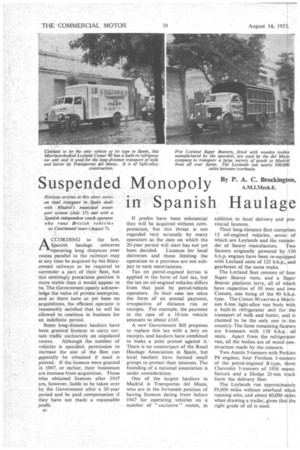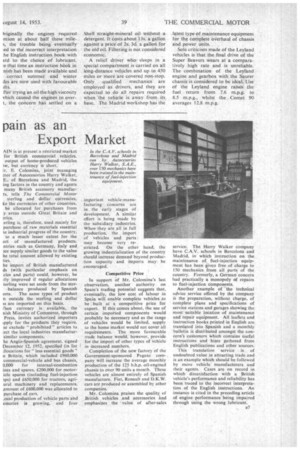S uspended Monopoly By P. A. C. Brockin
Page 40

Page 41

If you've noticed an error in this article please click here to report it so we can fix it.
Spanish Haulag
ASCCORDING to the law, panish haulage concerns operating long distances over routes parallel to the railways may at any time be acquired by the Stateowned railways or be required to' surrender a part of their fleet, but this seemingly precarious position is more stable than it would appear to be. The Government openly acknowledge the value of private enterprise, and as there have as yet been no acquisitions, the efficient operator is reasonably satisfied that he will be allowed to continue in business for an indefinite period.
Some long-distance hauliers have been granted licences to carry certain traffic exclusively on stipulated routes. Although the number of vehicles is specified, permission to increase the size of the fleet can generally be obtained if need is proved. If the licences were -granted in 1947, or earlier, their businesses are immune from acquisition. Those who obtained licences after 1947 are, however, liable to be taken over by the Government after a 20-year period and be paid compensation if they have not made a reasonable profit. If profits have been substantial they will be acquired without compensation, but this threat is not regarded very seriously by many operators as the date on which the 20-year period will start has not yet been decided. Licences for local deliveries and those limiting the operation to a province are not subject to such uncertainties.
Tax on petrol-engined lorries is applied in the form of fuel tax, but the tax on oil-engined vehicles differs from that paid by petrol-vehicle operators. In their case tax takes the form of an annual payment, irrespective of distance run or receipts. For example, the payment in the case of a 10-ton vehicle amounts to about £145.
A new Government Bill proposes to replace this tax with a levy on receipts, and hauliers have combined to make a joint protest against it. There is no counterpart of the Road Haulage Association in Spain, but local hauliers have formed small groups to protect their interests. The founding of a national association is under consideration.
One of the largest hauliers in Madrid is Transportes del Mazo, who are in the fortunate position of having licences dating from before 1947for operating vehicles on a number of " exclusive " routes, in
addition to local delivery and provincial licences.
Their long-distance fleet comprises 12 oil-engined vehicles, _ seven of which are Leylands and the remainder of Saurer manufacture. Two Saurers originally powered by 150 b.h.p. engines have been re-equipped with Leyland units of 125 b.h.p., ,and gearboxes of the same make.
The Leyland fleet consists of four Super Beaver vans, and a Super Beaver platform lorry, all of which have capacities of 10 tons and two Comets, one being of the 90 b.h.p. type. The Comet 90 carries a Morrison 6-ton light-alloy van body with a built-in refrigerator unit for the transport of milk and butter, atid is claimed to be the only one in the country. The three remaining Saurers are 8-tonners with 110 b.h.p. oil units. Apart from the refrigerator van, all the bodies are of wood construction made by the concern.
Two Austin 5-tonners with Perkins P6 engines, four Forclson 3-banners of the petrol-engined B-type, t ree Chevrolet 3-tonners of 1936 m nufacture and a Dodge 21-ton t uck form the delivery fleet.
The Leylands run approximately 95,000 miles without overhaul when running solo, and about 60,000 fillies when drawing a trailer, given that the right grade of oil is used. kiginally the engines required Mimi at about half these mile
s, the trouble being eventually ;ed to the incorrect interpretation he English instruction book with ird to the choice of lubricant. :e that time an instruction bliok in nish has been made available and
correct summer and winter des are now used with favourable sits.
fter trying an oil the high viscosity vhich caused the engines to over t, the concern has settled on a
Shell straight-mineral oil; without a detergent. It costs about 13s.. a gallon against a price of 2s, 3d. a gallon for the old oil. Filtering is not considered economic.
A relief driver who sleeps in a special compartment is carried on all Iling-distance vehicles and up to 450 miles or more are covered non-stop. Only qualified mechanics are employed as drivers, and, they are expected to do all repairs required when the vehicle is avvay. from its base. The Madrid workshop has the latest type of maintenance equipment for the complete overhaul of chassis and power units.
Sole criticism made of the Leyland vehicles is that the final drive of the Super Beavers wears at a comparatively high rate and is unreliable. The combination of the Leyland engine and gearbox with the Saurer chassis is considered to be ideal. Use of the Leyland engine raises the fuel return from 7.6 m.p.g. to 8.5 m.p.g., whilst the Comet 90 averages 12.8 m.p.g.




















































































